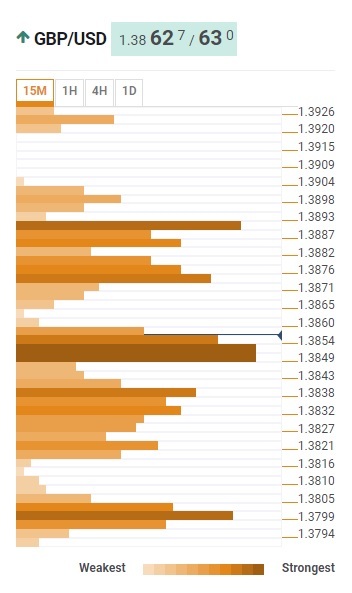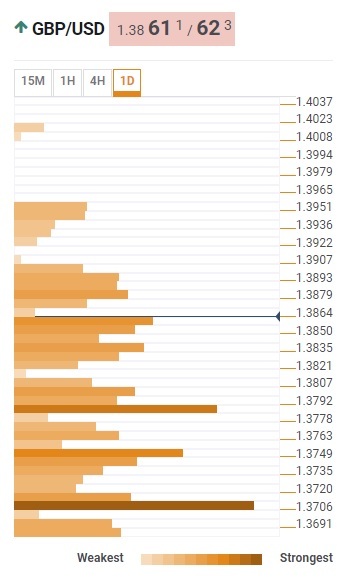After reaching a new post-Brexit high of $1.3940 overnight, the GBP/USD corrected lower towards round big figure of $1.3800 just to gain back about half of the retracement to trade at $1.2860.
With no news on the macro calendar scheduled for Thursday, the GBP/USD is driven by market sentiment, especially concerning the US Dollar as the US is facing the government shutdown since January 19 should the US Congress fail to avert the issue by increasing the debt ceiling.
Technically the GBP/USD busted the resistance at $1.3850 representing 61.8% Fibonacci retracement line of post-Brexit slide lower. Although GBP/USD failed to close on Wednesday above that key resistance line, the push higher for GBP is very strong as the currency pair has managed to break above that level easily multiple time during the day.
The FXStreet confluence indicator that analyses multi-factor coincidence of different technical barriers points to $1.3890 as a near-term resistance on a 15-minute chart while longer-term picture sees no big barrier for GBP/USD until round big figure of $1.4000. Failure to close above $1.3850 will bring $1.4000 as next target for traders.
FXStreet 15 minutes and daily confluence indicators


With technical hurdle already busted at $1.3850, the oscillators are painting picture of a corrective move sideways with both Slow Stochastics and the Relative Strength Index moving downwards from the Overbought territory. The momentum indicator is also pointing downwards on a daily chart.
GBP/USD daily chart

Note: All information on this page is subject to change. The use of this website constitutes acceptance of our user agreement. Please read our privacy policy and legal disclaimer. Opinions expressed at FXstreet.com are those of the individual authors and do not necessarily represent the opinion of FXstreet.com or its management. Risk Disclosure: Trading foreign exchange on margin carries a high level of risk, and may not be suitable for all investors. The high degree of leverage can work against you as well as for you. Before deciding to invest in foreign exchange you should carefully consider your investment objectives, level of experience, and risk appetite. The possibility exists that you could sustain a loss of some or all of your initial investment and therefore you should not invest money that you cannot afford to lose. You should be aware of all the risks associated with foreign exchange trading, and seek advice from an independent financial advisor if you have any doubts.
Recommended Content
Editors’ Picks
AUD/USD could extend the recovery to 0.6500 and above

The enhanced risk appetite and the weakening of the Greenback enabled AUD/USD to build on the promising start to the week and trade closer to the key barrier at 0.6500 the figure ahead of key inflation figures in Australia.
EUR/USD now refocuses on the 200-day SMA

EUR/USD extended its positive momentum and rose above the 1.0700 yardstick, driven by the intense PMI-led retracement in the US Dollar as well as a prevailing risk-friendly environment in the FX universe.
Gold struggles around $2,325 despite broad US Dollar’s weakness

Gold reversed its direction and rose to the $2,320 area, erasing a large portion of its daily losses in the process. The benchmark 10-year US Treasury bond yield stays in the red below 4.6% following the weak US PMI data and supports XAU/USD.
Bitcoin price makes run for previous cycle highs as Morgan Stanley pushes BTC ETF exposure

Bitcoin (BTC) price strength continues to grow, three days after the fourth halving. Optimism continues to abound in the market as Bitcoiners envision a reclamation of previous cycle highs.
US versus the Eurozone: Inflation divergence causes monetary desynchronization

Historically there is a very close correlation between changes in US Treasury yields and German Bund yields. This is relevant at the current juncture, considering that the recent hawkish twist in the tone of the Federal Reserve might continue to push US long-term interest rates higher and put upward pressure on bond yields in the Eurozone.